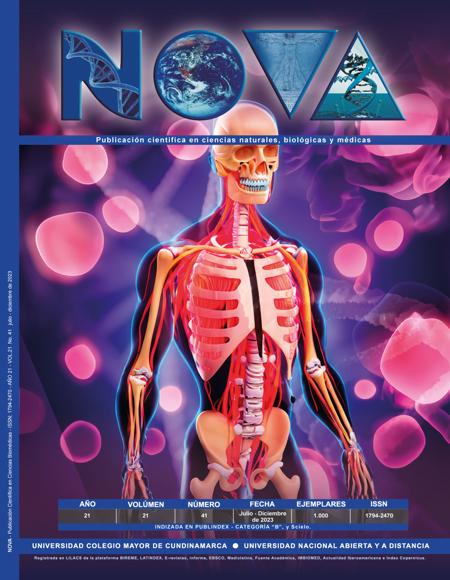ObRb, AdipoR1, and CYP19 gene expression show significant association with obesity and overweight in healthy women
ObRb, AdipoR1, and CYP19 gene expression show significant association with obesity and overweight in healthy women

Esta obra está bajo una licencia internacional Creative Commons Atribución-NoComercial-SinDerivadas 4.0.

NOVA por http://www.unicolmayor.edu.co/publicaciones/index.php/nova se distribuye bajo una Licencia Creative Commons Atribución-NoComercial-SinDerivar 4.0 Internacional.
Así mismo, los autores mantienen sus derechos de propiedad intelectual sobre los artículos.
Mostrar biografía de los autores
Obesity and overweight are diseases characterized by excessive accumulation of adipose tissue in the body and are defined as an increase in Body Mass Index (BMI) with values greater than 25 kg/m2. Multiple causes of these increases in BMI have been reported. Some have been attributed to the expression of several genes involved in the leptin and adipo- nectin pathway as well as postmenopausal stage in women.
In this research, we focused on evaluating whether the expression of ObRb, AdipoR1, and CYP19 genes have any association with the increase in BMI in the female population of Mexico City over 55 years of age. For this, we worked with a group of 45 women volunteers without the diagnosis of any confirmed pathology.
The study population was classified into three groups (average weight, overweight and obese) according to their BMI and was characterized according to their clinical data of blood cytometry and blood chemistry. At the same time, RT-PCR determined ObRb, Adi- poR1, and CYP19 gene expression.
Visitas del artículo 115 | Visitas PDF 103
Descargas
Malo SM, Castillo MN, Pajita DD. Obesity in the world. An la Fac Med. 2017;78(2):67.
Wang Y, Beydoun MA, Liang L, Caballero B, Kumanyika SK. Will all Americans become overweight or obese? Estimating the progression and cost of the US obesity epidemic. Obesity. 2008;16(10):2323–30.
Encuesta Nacional de Salud y Nutrición 2018. Instituto Nacional de Estadística y Geografía, Instituto Nacional de Salud Pública, Secretaría de Salud;1:47.
Guendelman S, Ritterman-Weintraub ML, Fernald LCH, Kaufer-Horwitz M. A population-based comparison of weight and weight perceptions among overweight and obese Mexican and Mexican-American men. Salud Publica Mex. 2013;55(1 SUPPL.4):451–8.
Herrera B, Lindgren C. The genetics of obesity. Curr Diab Rep. 2010;10(6):498–505.
Ristow M, Müller-Wieland D, Pfeiffer A, Krone W, Kahn CR. Obesity Associated with a Mutation in a Genetic Regulator of Adipocyte Differentiation. New England Journal of Medicine. 2002;339(14):953–9.
Obesidad y sobrepeso; 2020. Organización Mundial de la Salud.
Wyatt SB, Winters KP, Dubbert PM. Overweight and obesity: Prevalence, consequences, and causes of a growing public health problem. Am J Med Sci. 2006;331(4):166–74.
Crake RLI. Exploring Molecular Links between Obesity and Breast Cancer. 2015.
D’Angelo CS, Varela MC, De Castro CIE, et al. Chromosomal microarray analysis in the genetic evaluation of 279 patients with syndromic obesity. Mol Cytogenet. 2018;11(1):1–18.
Nickel A, Blücher C, Kadri O Al, et al. Adipocytes induce distinct gene expression profiles in mammary tumor cells and enhance inflammatory signaling in invasive breast cancer cells. Sci Rep. 2018;8(1):9482.
Pavón De Paz I, Alameda Hernando C, Olivar Roldán J. Obesity and menopause. Nutr Hosp Organo Of la Soc española Nutr Parenter y Enter. 2006;21(6):633–7.
Garaulet M, Pérez-Llamas F, Zamora S, Javier Tébar F. Comparative study of the type of obesity in pre- and postmenopausal women: Relationship with fat cell data, fatty acid composition and endocrine, metabolic, nutritional and psychological variables. Med Clin. 2002;118(8):281–6.
Moleres A., Martinez JA., Marti A. Genetics of obesity. Aust Fam Physician. 2017;46(7):456–9.
Scuteri A, Sanna S, Chen WM, et al. Genome-wide association scan shows genetic variants in the FTO gene are associated with obesity-related traits. PLoS Genet. 2007;3(7):1200–10.
Singh RK, Kumar P, Mahalingam K. Molecular genetics of human obesity: A comprehensive review. Comptes Rendus - Biol. 2017;340(2):87–108.
Thaker VV. Genetic and Epigenetic Causes of Obesity. Adolesc Med State Art Rev. 2017;28(2):379–405.
González JE. Genes and obesity: a cause and effect relationship. Endocrinol y Nutr. 2011;58(9):492–6.
Martos GÁ, Serra JC, Pérez JL, Argente J. Aspectos genéticos de la obesidad. Rev Esp Endocrinol Pediatr. 2017;8:21–32.
Rankinen T, Zuberi A, Chagnon YC, et al. The human obesity gene map: The 2005 update. Obesity. 2005;14(4):529–644.
García TD, Castellanos MF, Cedeño MR, Benet RM, Ramírez AI. Adipose tissue as an endocrine glans. Pathophysiological implications. Finlay. 2014;1(2):131–6.
Garcés MF, Gomes B, Stekman H, Hernández C, López, Soto I. Polimorfismos G2548A del gen de leptina y Gln223Arg del gen repector de leptina en pre-púberes con riesgo cardiometabolico. Arch Venez Pueric Pediatr. 2016;79(1):54–61.
Geriki S, Bitla AR, SrinivasaRao PVLN, et al. Association of single nucleotide polymorphisms of adiponectin and leptin genes with breast cancer. Mol Biol Rep. 2019;46(6):6287–97.
Fangyi G. Leptin and leptin receptor genes in relation to premenopausal breast cancer incidence and grade in Caucasian women. Breast Cancer Res Treat. 2013;23(1):1–7.
Mahmoudi R, Noori AB, Nazer MMA, Fararouei M, Nikseresht M. Polymorphisms of Leptin (-2548 G/A) and Leptin Receptor (Q223R) Genes in Iranian Women with Breast Cancer. Int J Genomics. 2015;2015.
Daghestani M, Purohit R, Daghestani M, Daghistani M, Warsy A. Molecular dynamic (MD) studies on Gln233Arg (rs1137101) polymorphism of leptin receptor gene and associated variations in the anthropometric and metabolic profiles of Saudi women. PLoS One. 2019;14(2):1–15.
27. Karim S, Merdad A, Schulten HJ, et al. Low expression of leptin and its association with breast cancer: A transcriptomic study. Oncol Rep. 2016;36(1):43–8.
28. Rodríguez A, Echandía C, Sánchez A, et al. Complexity of the expression of genes associated with obesity in human adipose tissue. Rev Med. 2018;26(1):2018.
29. GómezRP,AlarcónSA,RodríguezWF,DíazGE.Adiponectin as therapeutic targe. Med Interna Mex. 2017;33(6):770–7.
30. Martinez JE, Suárez JA, Martínez M, et al. Role of adiponectine on obesity and diabetes type 2. Med Interna Mex. 2019;35(3):389–96.
31. Rasmussen MS, Lihn AS, Pedersen SB, Bruun JM, Rasmussen M, Richelsen B. Adiponectin receptors in human adipose tissue: Effects of obesity, weight loss, and fat depots. Obesity. 2006;14(1):28–35.
32. Chen J, Shen S, Tan Y, et al. The correlation of aromatase activity and obesity in women with or without polycystic ovary syndrome. J Ovarian Res. 2015;8(1):4–9.
33. Gennari L, Masi L, Merlotti D, et al. A polymorphic CYP19 TTTA repeat influences aromatase activity and estrogen levels in elderly men: Effects on bone metabolism. J Clin Endocrinol Metab. 2004;89(6):2803–10.
34. Declaraciòn de Helsinki de la AMM – Principios Éticos para las Investigaciones Mèdicas en seres humanos, 2013. Asociaciòn Mèdica Mundial.
35. Linares RL, Santillán JGB, Ortiz MR, Romero CG, Sandoval- Cabrera A. Modulation of the leptin receptors expression in breast cancer cell lines exposed to leptin and tamoxifen. Sci Rep. 2019;9(1):1–9.
36. Mociño MDR, Santillán JGB, Dozal DSD, et al. Expression of AdipoR1 and AdipoR2 Receptors as Leptin-Breast Cancer Regulation Mechanisms. Dis Markers. 2017;2017:1–11.
37. Mirele DO, Fagundes R, Moreira E, de Moraes Trindade E, de Carvalho T. Relación de indicadores antropométricos con factores de riesgo para enfermedad cardiovascular. Arq Bras Cardiol. 2010;94(4):462–9.
Domínguez TR, Quiroz IV, Bernabé ABS, Goytia LS, Valle JFM, Isela PR. Las medidas antropométricas como indicadores predictivos de riesgo metabólico en una población mexicana. Nutr Hosp. 2016;31(4):6–14.
Cedeño RM, Castellanos MBG-RMG, Mass LS, Mora CH, Parada JA. Anthropometric Indicators to Determine the Obesity and its Relations with the Cardiometabolic Risk. Rev Finlay, 2015;5(1):11.
Guia para la prevencion, diagnostico y tratamiento del sobrepeso y obesidad. 2012; IMSS.
Lau D, Douketis D, Morrison K, Hramiak I, Sharma A, Ur E. Canadian Guidelines for obesity. Can Med Assoc J. 2007;176(8).
Calleja HG, Sanchez DL. Relación entre circunferencia abdominal e índice de masa corporal con los niveles de colesterol total y trigliceridos en los pacientes que acuden la centro de saul rural disperso Santa Maria, Mexico. Universidad Autonoma del Estado de México. 2012.
Pavía AA, Aguilar CS. Mexican guidelines in the diagnosis and treatment of dyslipidemias and atherosclerosis. Statement of the Mexican Society of Cardiology. Med Interna Mex. 2020;36(3):390–413.
Fuentes GO, Mata AH. Frecuencia de hipertrigliceridemias en población mexicana ambulatoria. Rev Latinoam Patol Clínica y Med Lab. 2013;60(2):110–5.
Carranza LM. Triglycerides and cardiovascular risk. Med Int Méx. 2017;33(4):511–4.
Escobedo JP, De Jesús P, Schargrodsky H, Champagne B. Prevalencia de dislipidemias en la ciudad de México y su asociación con otros factores de riesgo cardiovascular. Gac Med Mex. 2014;150:1–9.
Collares RVA, Salgado W, Da Cunha Tirapelli DP, Dos Santos JS. The expression of LEP, LEPR, IGF1 and IL10 in obesity and the relationship with microRNAs. PLoS One. 2014;9(4):1–6.
Yiannakouris N, Yannakoulia M, Melistas L, Chan JL, Klimis-Zacas D, Mantzoros CS. The Q223R polymorphism of the leptin receptor gene is significantly associated with obesity and predicts a small percentage of body weight and body composition variability. J Clin Endocrinol Metab. 2001;86(9):4434–9.





